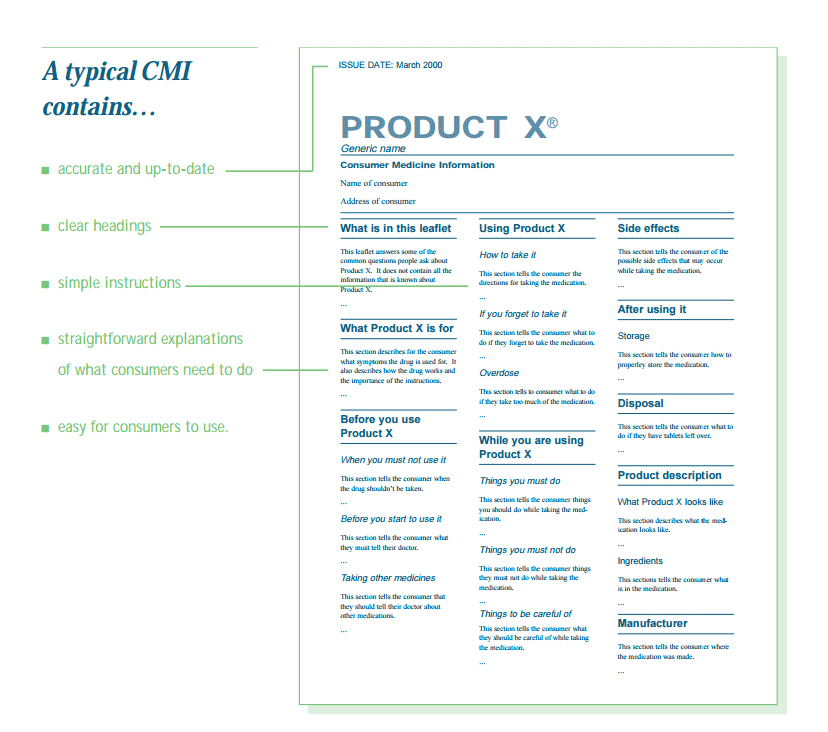Patient information leaflets provided with the medication seem to be very easy to read and understand. This statement is not true. They are not so simple to follow especially for people without specific education and experience. That is why the leaflets are left without proper attention.
Often leaflets are just thrown away after the simple “take two pills per day”. However our health once lost won’t be restored completely. Therefore it is vitally important to read the leaflet to any drug you take thoroughly in order to understand at least what to ask the doctor about and what to be ready for if any problem occurs. So, read medication information leaflets and don’t hesitate to ask questions if something is not clear for you!
What information leaflet contains
As a rule, the common patient information leaflet contains general description of the medication, its pharmaceutical content, storage conditions, package etc. Then the information about pharmacological action of the drug goes. Usually this section includes description of pharmacokinetics and pharmacodynamics which are needed mainly for the doctors.
 The other important sections involve therapeutic indication, rules of intake which are of great importance for the patient, information about side effects, contraindications and special notes, if needed. Besides, every information leaflet contains the detailed information about the producer of the medication as well as the organization which work with customers’ complaints.
The other important sections involve therapeutic indication, rules of intake which are of great importance for the patient, information about side effects, contraindications and special notes, if needed. Besides, every information leaflet contains the detailed information about the producer of the medication as well as the organization which work with customers’ complaints.
In this article comprehensive information about every section of the leaflet is provided with the help of Canadian Health Care Mall (website), one of the largest web portal dedicated to the medical questions. There you can find great pile of information about medications, their application and other related facts that will help you be aware of the subject and avoid undesired consequences for your health.
Product description
Any instruction always contains the market name of the product and active substance or substances, if more than one, as well as auxiliary elements. Such elements do not influence the therapeutic effect of the medication, but are responsible for the drug’s color, shape, taste and some additional properties.
Knowing the name of the active substance is very useful for you as you can find cheaper generic versions of the branded drug. Pharmaceutical companies often use different market names for the generic products they produce. As you know generics has the same pharmaceutical content as the branded product and, of course, the same active substance. For example, Tadalafil is a major ingredient of Cialis. Knowing that you can search for the information which medications contain the same substance and find out that there are a lot of analogues such as Tadacip, Tadalis and other drugs can be applied instead.
This section also contains information regarding the necessary storage conditions and available package sizes. As far as the storage is concerned it is necessary to follow the recommendations provided in the leaflet. Medications stored in cool and dry place should be put into hot places near the open fire and so on. If the drug should be stored in dark place it is necessary to put it into the tightly closed cabinet.
Another important thing you must remember: any drug must be kept away from the reach of small children!
Pharmacological action
Each leaflet contains the sections called “Pharmacokinetics” and “Pharmacodynamics”. To tell the truth these sections are designed for the doctors so people without special knowledge cannot figure out what is written inside. However, it is pharmacological action that influences all the other things like therapeutic application, contraindications and side effects.
Pharmacokinetics describes the way the medication passes through the human body, what the speed of drug absorption is, when the medication starts acting, where and how it is degraded and how it is removed from the body. There are several ways of drug removal that are kidneys, liver and lungs.
Usually here one stipulates the period of time needed for the medical substance to be completely removed from the body. This information defines the frequency of the drug intake. Thus, if the leaflet says that one should take the drug three times per day the patient should follow this schedule. If he break these rules the concentration of the medication in the body will be either insufficient to make therapeutic effect or excessive to cause certain side effects.
Pharmacodynamics describes what is going on with the drug in the body. It is a chemical substance so it interacts with something and accumulates somewhere in the body. That is why the effectiveness of the treatment depends upon where and how the medication gets inside the body. This important information influences the doctor’s decision to prescribe the certain drug. It is no use to prescribe, for example, some antibiotic drug accumulated in the bone tissue to treat the pneumonia.
Therapeutic indication
It is one of the most important sections of the product leaflet as it tells about what the given medication is tailored for. What is the purpose of buying the medication aimed at the treatment of gastrointestinal disorders to treat erectile dysfunction, for example?
Rules of intake
At first sight this section is the simplest part of the leaflet. However, there is also information that should be explained. “Before meals” means that the medication should be taken 15-20 minutes before eating. “After meals” means 15-20 minutes after eating. If the medication should be taken “under fasting condition” you should take it 30-60 minutes before breakfast. “Before sleeping” means 30 minutes before you go to bed. Dosages stipulated in the leaflet are standard, so they can and should be defined individually depending upon the patient’s health state.
Side effects
It is considered to be one of the most “horrible” sections in the leaflet. Sometimes doctors recommend not even to peep there. In fact, there is a certain reason for that as everybody knows about the effect of suggestion. Very sensitive people can even feel what they read about and just give up treating. That is why the best way is to walk about the subject with the doctor. In this case you will be aware of what to do if any side effect occurs and how they are harmful for your health.
The first thing you should know about the quantity of side effects listed in the leaflet is the more side effects are given, the more the medication is studied. On the contrary, if there are no side effects or they are few it means that the medication is not well-studied and side effects can be revealed in years.
Pharmaceutical companies thoroughly compile the list of all the side effects and include even those that are experienced very rear. It is done in order to avoid law claims.
By the way, side effects can be of different nature. The first group is connected with the pharmacological action of the drug that is its influence not only on the organ it is designed for, but also on the other internal organs and systems where similar chemical reactions take place. Aspirin and other non-steroidal anti-inflammatory drugs cab ne taken as an example. They inhibit the inflammation and remove the pain; however at the same time they disturb the blood circulation in the stomach walls. Thus, stomach ulcer may occur as a side effect.
Various allergic reactions may also become the side effect of any medication. Pharmaceutical substances may cause allergic reactions so you’d better read the medication content including auxiliary substances especially if you are prone to allergy. If you are allergic to chocolate, for example, you should not use suppositories with cocoa butter. If you had allergy to penicillin all the antibiotics of the given group are not recommended for you. That is why don’t forget to inform your doctor about your limitations. Overdosing is another reason of side effect occurrence. Overdosing occurs not only in the case when too many pills were taken. Sometimes the concentration of the medication in the human body may become toxic. Why do this happen and how can one prevent it?
It is pharmacokinetics that can explain the case. If the medication is removed via kidneys this organ must work well otherwise it will fail to remove the substance and cause the risk of overdosing. If the liver is involved the situation is the same. You should remember whether you have any problems with liver and bile ducts or not. Certainly, you should inform your doctor about your health problems in order to prevent harmful situations.
Contraindications
Everything is clear in this section as it describes cases when side effects are nearly inevitable and the harm of the drug intake is much higher than the benefit. You should study this section if you have any health disorder or take other medications.
All the medications have contraindications. Even those ones considered to be common and harmless have certain contraindications. For example, vasoconstrictive agents are very popular with patients and are usually taken without any doctor’s consultations. Moreover, often even the patient information leaflet is simply thrown away. However these medications are contraindicative in case of high blood pressure, tachycardia, glaucoma and other diseases. Studying the sub-section of drug interaction is also of great importance as some medications cannot be co-administered as they may cause certain harm for your health.
Special notes
This section should also be paid special attention especially if you buy the medication without prescription or your doctor said nothing about it. This section includes cases, diseases or other health states that can trigger negative effects of the drug. The simplest example is: work that requires increased attention, driving, lactation period etc.



